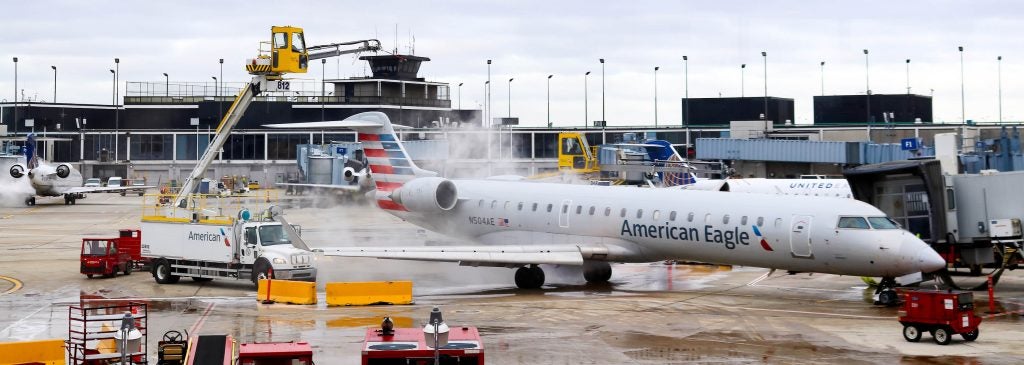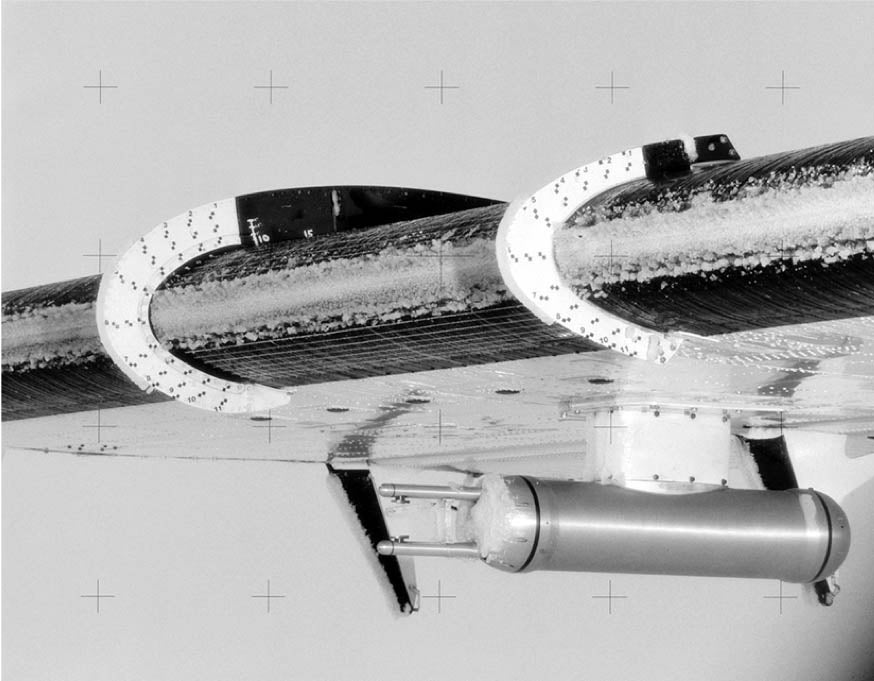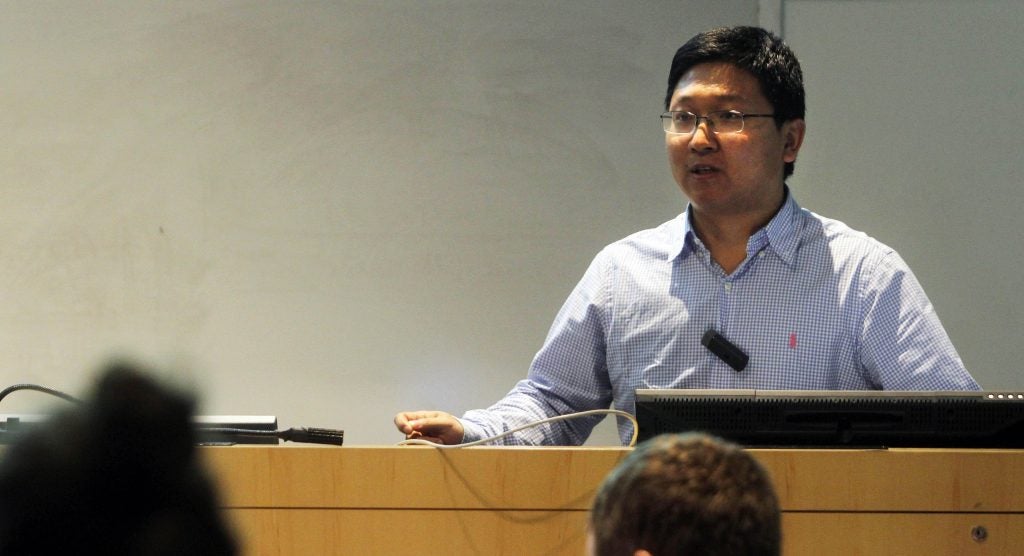ECU professor’s research on ice may help improve aircraft safety
On a frigid November day in 2004, Chinese Eastern Airlines Flight 5210 dropped out of the sky shortly after takeoff from the Baotou Eriban Airport, exploding on the ground and then sliding into a lake. All 53 people on the plane and two people on the ground died.
“That was my hometown. At the time, I was in my first year in high school,” said Dr. Yang Liu, an assistant professor in East Carolina University’s Department of Engineering. “The aircraft crashed due to ice accumulation on the wings.”
The crash stayed with Liu, and so when he went to college, he majored in aerospace engineering. Today, along with his teaching duties, Liu is working to prevent similar crashes from ever happening again through research on aircraft anti-icing and deicing methods.

An American Eagle aircraft is deiced at O’Hare Airport in Chicago. Dr. Yang Liu, an engineering professor at East Carolina University, is conducting research to help improve anti-icing and deicing techniques to help improve airline safety. (Photo from Bigstock)
“Over the past 40 years, there have been more than 1,000 icing related flight accidents just in the U.S. That’s a lot,” he said.
One of those was in 1982, when Florida Air Flight 90 took off in a snowstorm from Washington National Airport, hit a bridge and crashed into the ice-covered Potomac River. Four people on the bridge and 74 others on the plane died. A helicopter famously rescued five survivors from the water.
Ice buildup not only adds weight to an aircraft, but more importantly, can disrupt air flow, making the plane difficult to handle, and in the most tragic cases, impossible to fly.
“Each aircraft is designed perfectly to achieve a very high lift-drag ratio,” Liu said. “If there is ice there, the aerodynamics have changed. Once that has changed, the first thing is flight control problems.”
In 2009, a flight from Brazil to France crashed in the open Atlantic Ocean, killing 228. According to French investigators, ice crystals formed and blocked important sensors. The reaction of pilots to the information caused the plane to stall and eventually crash. From 2010-2014, a National Transportation Safety Board report notes 78 fatalities related to ice-related plane crashes in the United States.
“There are so many ice-related flight accidents. We need to do something to prevent that from happening,” Liu said. “Most fundamental is how can we better predict the icing phenomena on aircraft.”

Ice accretion around the leading edge of an aircraft wing is pictured. (Thomas Ratvasky and Kurt Blankenship, NASA Glenn Research Center)
Liu has been involved in aircraft icing research at Iowa State and has continued with his efforts since coming to ECU last year. One area of his research involves improvement to models used to predict ice formation on aircraft. To improve the model, researchers need to know the physics behind ice formation on aircraft.
“I want to know how the (water) droplet deforms and freezes at the instant it impacts the aircraft surface under different temperature conditions,” Liu said. “This is very fundamental physics. If we can get this, we will have a better model for icing predictions. This is very important.”
Liu also hopes to improve anti-icing and deicing techniques. Those techniques start on the ground when planes are deiced using a fluid mixture.
“Those fluids are chemicals, and there is a huge amount of that fluid used to remove the ice,” Liu said. “The fluid goes into the soil and underground and may cause very severe pollution for the environment around the airport. That is a very big issue as well. People are trying to investigate new chemicals to try to minimize that effect.”
Anti-icing continues when the aircraft is in the air. Liu said that 90% of commercial aircraft use a thermal method.
“They heat up the wing surface to prevent icing or to remove the ice creation,” Liu said. “One big challenge is that it is very energy consuming. Aircraft have limited energy storage. If a lot of the energy is utilized to heat up the surface for anti- or deicing, it will be a big issue for the aircraft system. However, there is no better method currently, so that is something I’ve been doing for the last three years.”

Dr. Yang Liu talks about his research during a lightning talk event at the Science and Technology Building.
(Photo by Ken Buday)
Researchers have also looked at coating the outside of the aircraft with something that would prevent ice formation. Liu has been hands-on with some of that research at Iowa State.
“To be honest, there’s no perfect commercial icephobic coating available for aircraft,” Liu said. “People are trying to investigate reliable, durable and effective coatings for aircraft icing mitigation. I haven’t seen any perfect ones so far.”
However, Liu said two methods for in-flight anti-icing look promising. One would involve heating a smaller portion of the wing surface in combination with an icephobic coating.
“We did a test and saved 90% of the energy,” Liu said.
Another proposal would use plasma technology that is already used for flow control on aircraft. Liu said the hot gas layer generated in plasma actuation is just above the aircraft’s surface and can be used for icing control so that impinged water on the plane is too warm to form ice.
“It is still in the lab stage. We haven’t applied it on any real aircraft yet,” Liu said. “However, it is a new way that is more efficient and saves more energy.”
Liu has an advanced thermal flow diagnostics lab in the Science and Technology Building where he plans to continue his research, and he is in the process of generating funding proposals to various agencies.
“Nowadays, people have methods to remove ice from aircraft, but all of these methods have drawbacks,” Liu said. “We need to continue our efforts to improve that and make it environmentally friendly, make it more efficient and make it safer. This is what we want to achieve.”
-by Ken Buday, University Communications